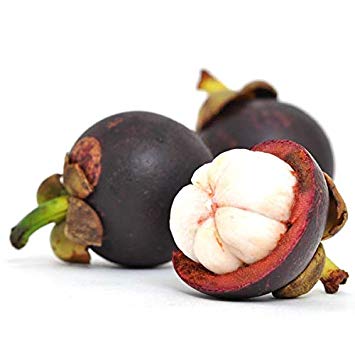

The purple mangosteen (Garcinia mangostana), known simply as mangosteen, is a tropical evergreen tree believed to have originated in the Sunda Islands of the Malay archipelago and the Moluccas of Indonesia. It grows mainly in Southeast Asia, southwest India and other tropical areas such as Puerto Rico and Florida, where the tree has been introduced. The tree grows from 6 to 25 m (19.7 to 82.0 ft) tall. The fruit of the mangosteen is sweet and tangy, juicy, somewhat fibrous, with fluid-filled vesicles (like the flesh of citrus fruits), with an inedible, deep reddish-purple colored rind (exocarp) when ripe. In each fruit, the fragrant edible flesh that surrounds each seed is botanically endocarp, i.e., the inner layer of the ovary. Seeds are almond-shaped and -sized.
The purple mangosteen belongs to the same genus as the other, less widely known, mangosteens, such as the button mangosteen (G. prainiana) or the charichuelo (G. madruno).
A tropical tree, the mangosteen must be grown in consistently warm conditions, as exposure to temperatures below 0 °C (32 °F) for prolonged periods will usually kill a mature plant. They are known to recover from brief cold spells rather well, often with damage only to young growth. Experienced horticulturists have grown this species outdoors, and brought them to fruit in extreme south Florida.
The juvenile mangosteen fruit, which does not require fertilisation to form (see agamospermy), first appears as pale green or almost white in the shade of the canopy. As the fruit enlarges over the next two to three months, the exocarp colour deepens to darker green. During this period, the fruit increases in size until its exocarp is 6–8 centimetres (2.4–3.1 in) in outside diameter, remaining hard until a final, abrupt ripening stage.
The subsurface chemistry of the mangosteen exocarp comprises an array of polyphenols, including xanthones and tannins that assure astringency which discourages infestation by insects, fungi, plant viruses, bacteria and animal predation while the fruit is immature. Colour changes and softening of the exocarp are natural processes of ripening that indicates the fruit can be eaten and the seeds have finished developing.
Once the developing mangosteen fruit has stopped expanding, chlorophyll synthesis slows as the next colour phase begins. Initially streaked with red, the exocarp pigmentation transitions from green to red to dark purple, indicating a final ripening stage. This entire process takes place over a period of ten days as the edible quality of the fruit peaks.
Over the days following removal from the tree, the exocarp hardens to an extent depending upon post-harvest handling and ambient storage conditions, especially relative humidity levels. If the ambient humidity is high, exocarp hardening may take a week or longer when the flesh quality is peaking and excellent for consumption. However, after several additional days of storage, especially if unrefrigerated, the flesh inside the fruit might spoil without any obvious external indications. Using the hardness of the rind as an indicator of freshness for the first two weeks following harvest is therefore unreliable because the rind does not accurately reveal the interior condition of the flesh. If the exocarp is soft and yielding as it is when ripe and fresh from the tree, the fruit is usually good.
The edible endocarp of the mangosteen has the same shape and size as a tangerine 4–6 centimetres (1.6–2.4 in) in diameter, but is white. The number of fruit segments corresponds exactly with the number of stigma lobes on the exterior apex; accordingly, a higher number of fleshy segments also corresponds with the fewest seeds. The circle of wedge-shaped segments contains 4–8, rarely 9 segments, the larger ones harbouring the apomictic seeds that are unpalatable unless roasted. As a non-climacteric fruit, a picked mangosteen does not ripen further, so must be consumed shortly after harvest.
Often described as a subtle delicacy, the flesh bears an exceptionally mild aroma, quantitatively having about 1/400th of the chemical constituents of fragrant fruits, explaining its relative mildness. The main volatile components having caramel, grass and butter notes as part of the mangosteen fragrance are hexyl acetate, hexenol and α-copaene.